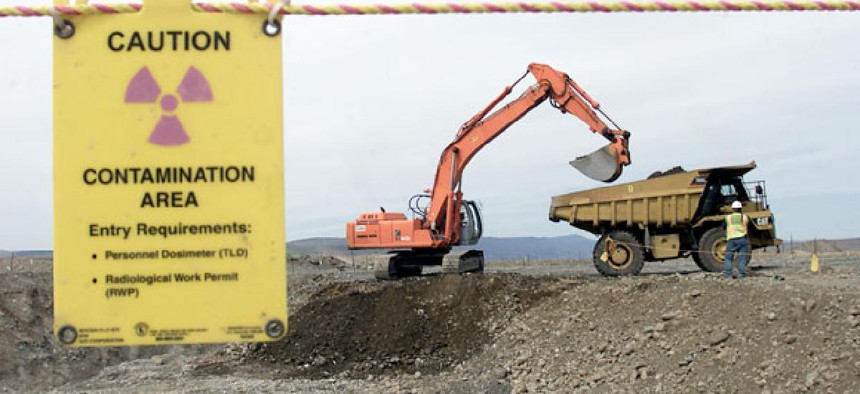EPA Relaxes Public Health Guidelines For Radiological Attacks, Accidents

Jackie Johnston/AP file photo
Watchdog groups blast a new guide for coping with a disaster's environmental fallout.
After years of internal deliberation and controversy, the Obama administration has issued a document suggesting that when dealing with the aftermath of an accident or attack involving radioactive materials, public health guidelines can be made thousands of times less stringent than what the U.S. Environmental Protection Agency would normally allow.
The EPA document, called a protective action guide for radiological incidents, was quietly posted on a page on the agency’s website Friday evening. The low-profile release followed an uproar of concern from watchdog groups in recent weeks over news that the White House had privately agreed to back relaxed radiological cleanup standards in certain circumstances and had cleared the path for the new EPA guide.
Agency officials had tried to issue the protective action guide during the final days of the Bush administration in January 2009, but the incoming Obama camp ultimately blocked its publication in part due to concerns that it included guidelines suggesting people could drink water contaminated at levels thousands of times above what the agency would typically permit.
The new version of the guide released Friday does not include such dramatically relaxed guidelines its text, but directs the reader to similar recommendations made by other federal agencies and international organizations in various documents. It suggests that they might be worth considering in circumstances where complying with its own enforceable drinking water regulations is deemed impractical.
Such circumstances could include the months – and possibly years – following a “dirty bomb” attack, a nuclear weapons explosion or an accident at a nuclear power plant, according to the guide, a nonbinding document intended to prepare federal, state and local officials for responding to such events.
For example, the new EPA guide refers to International Atomic Energy Agency guidelines that suggest intervention is not necessary until drinking water is contaminated with radioactive iodine 131 at a concentration of 81,000 picocuries per liter. This is 27,000 times less stringent than the EPA rule of 3 picocuries per liter.
“This is public health policy only Dr. Strangelove could embrace,” Jeff Ruch, executive director for the watchdog group Public Employees for Environmental Responsibility, said in a statement Monday, referring to Peter Sellers’ character in the Stanley Kubrick film of the same name.
Along with other activists, Ruch laid the blame for the document’s perceived shortcomings on Gina McCarthy, the EPA air and radiation chief who is scheduled for a Senate confirmation hearing on Thursday regarding her nomination to become the agency’s next administrator. “If this typifies the environmental leadership we can expect from Ms. McCarthy, then EPA is in for a long, dirty slog,” Ruch said.
In a statement to Global Security Newswire, EPA spokeswoman Julia Valentine said the new document does not propose specific drinking water guidelines, but rather seeks comment on what guidelines are appropriate. “The agency would like to hear from state and local partners on this issue and is seeking input from states and local authorities as it considers the appropriateness of, and possible values of, a drinking water PAG,” she said.
However, while the new guide will be subject to a 90-day public comment period once it formally is published in the Federal Register, it has been labeled for “interim use,” meaning it is effective immediately.
Daniel Hirsch, a nuclear policy lecturer at the University of California-Santa Cruz who led a coalition of some 60 watchdog groups against the Bush-era incarnation of the EPA guide, argued the Obama guide is worse than the Bush document in not only ultimately referencing many of the same controversial recommendations, but by forcing the reader to dig through a myriad of other documents to find them.
“What I find particularly tragic is, because it is so corrupt, it now is a useless document,” Hirsch told GSN. “If you have an emergency, you want to go to a protective action guide, look up tables, and know what you’re supposed to do.”
In Hirsch’s view, McCarthy, along with acting EPA Administrator Bob Perciasepe, “moved the most horrible stuff into references” so that “they could somehow claim that it is not identical to the Bush-era PAG.”
The new 86-page guide’s reliance on other documents is “a recipe for absolute mayhem in the midst of an emergency,” Hirsch said. “And that’s because of politics.”
Another controversial aspect of the Bush-era draft of the EPA guide was its embrace of a loosely defined approach to cleanup called optimization, under which decisions about how to permanently restore an area affected by a nuclear incident would not have to be based on the public health guidelines on which the agency usually relies.
According to a draft report recently commissioned by the Homeland Security Department, cleanup decisions under the optimization approach would be based on a target radiation dose range of between 100 and 2,000 millirems of radiation per year, meaning as many as about one in 20 people would be expected to develop cancer from long-term exposure. Historically, the Environmental Protection Agency has not allowed long-term cancer risks greater than one in 10,000 in a worst-case scenario, pursuant to guidelines its Superfund program established in the 1980s.
While the new EPA guide does not use the word “optimization,” it similarly suggests that compliance with the agency’s conventional guidelines might not be practical following the types of incidents the guide is meant to address.
“It should be noted that the extent and scope of contamination as a result of [a nuclear power plant, radiological “dirty bomb” or nuclear weapons incident] may be at a much larger scale than a site or facility decommissioned or remedial cleanup normally experienced under established regulatory frameworks,” says a draft of a Federal Register notice that will formally announce the document’s release. “Lesser radiological incidents may be well addressed under existing response and environmental cleanup programs.”
Watchdog organizations have argued, however, that the range of incidents which the new EPA guide and the DHS report suggest responders need not follow conventional health guidelines is too broad. Many scenarios involving a dirty bomb – a weapon that would use conventional explosive to disperse radioactive material -- are expected to contaminate areas smaller than many Superfund sites. Suggesting in a federal policy document that such cleanups need not follow conventional EPA rules could set a dangerous precedent for a wide range of situations, they have said. Some EPA and state government officials have raised similar concerns.
“Mixing in a [nuclear weapon] with a [dirty bomb] and a nuclear power accident and other kinds of accidents -- it’s just intellectually dishonest,” Hirsch said. “They should say our standard is to try to protect in the risk range we always have historically and there may be some absolutely exigent circumstances such as nuclear weapons explosion where that might be difficult but this is our goal and our planning basis.”
Suggestions in the new EPA guide that some radioactive waste might have to be dumped in conventional landfills due to a lack of sufficient space at specially designed sites has also sparked concern among activists.
Diane D’Arrigo, of the Nuclear Information and Resource Service, read these suggestions as “an admission that a nuclear power accident could cause major devastation and create enormous amounts of nuclear waste that would exceed all radioactive disposal capacity in the country so would need to go to regular landfills or be burned to disperse into our air and lungs.” She said the new guide was a “step toward making this an ‘acceptable’ practice,” in more routine situations.
Valentine, the EPA spokeswoman, said however that the new guide “will not affect the agency’s Superfund authorities, existing cleanup regulations or current health and safety standards,” despite the statements in the document suggesting those authorities, regulations and standards may not be applicable to a broad range of scenarios. She said the agency “is not weakening cleanup standards,” but rather, “building a bridge between managing the effects of a catastrophe and meeting existing environmental standards.”






